Sorting out some geese: Snow, Ross’s, Canada, and Cackling
This morning, I posted some videos of Snow Geese. My 2/15 blog was “Snow Geese – look carefully at each flock …….. ” I included a few photos in that blog, but just knew I had more and lo and behold, when looking through some of my thumb drives, there they were. With the exception of one photo taken by Larry Zirlin at Tom’s River in NJ, I took the photos of the geese in this blog at Desoto National Wildlife Refuge in Nebraska. If you have never been to Desoto, both Cleon and I recommend it – we love it there. Near Omaha, but quiet and secluded. We have always visited this refuge for several days from late August to late October and there has always been so much to see. So many birds. So much behavior to observe.
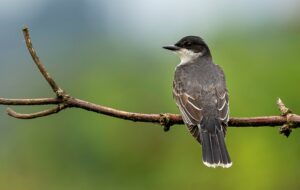
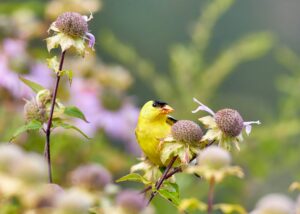
We once watched a flock of about 25 American Goldfinches land on tall prarie flowers – Ratibidas and Silphiums such as Grayhead Coneflower and Prairie Dock. And every time they landed and started foraging among the petals and newly forming seedheads, a flock of about a dozen Eastern Kingbirds swooped in and chased every single goldfinch away. Now why was that? The goldfinches were after petals and seedheads. Kingbirds eat insects and caterpillars. Two completely different foods. If the goldfinches had eaten every seed head on those plants, there would still be plenty of insects and caterpillars there for the kingbirds. We never came up with a good answer for this behavior except that kingbirds are always aggressive – always ready to engage. We assume they had claimed this large area of wildflowers and no one was allowed to infringe no matter who they were and what they would eat. We sat for an hour watching this behavior play out over and over. If any of those goldfinches got more than a bite, I would be surprised! Goldfinches are also aggressive and ready to fight anywhere and anytime, but we assume they knew they were no match for the larger, always aggressive kingbirds. But those goldfinches had to be tired, hungry, and totally frustrated! But I digress – back to the geese…..
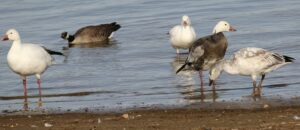
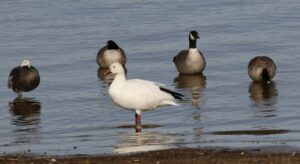 Both of these photos show Snow Geese with Canada Geese. Snow Geese (Anser caerulescens) have two morphs – a white one and a blue one. The photo on the left is the white morph and the photo on the right shows the blue morph. Both the blue and white morphs can be found together in flocks – they freely intermingle with each other. In my observations, the white morphs out number the blue morphs.
Both of these photos show Snow Geese with Canada Geese. Snow Geese (Anser caerulescens) have two morphs – a white one and a blue one. The photo on the left is the white morph and the photo on the right shows the blue morph. Both the blue and white morphs can be found together in flocks – they freely intermingle with each other. In my observations, the white morphs out number the blue morphs.
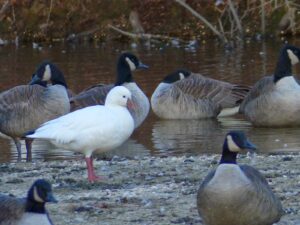
So how do Ross’s Geese (Anser rossii) fit in? Look at their range maps in your field guide or on allaboutbirds.org. I have never seen Ross’s Geese in flocks by themselves – I have always seen them within flocks of Snow Geese. And I have never seen Ross’s Geese in large numbers. What I have seen is several hundred or more Snow Geese all together in a flock and mixed in – but all close to each other within the flock – a dozen or so Ross’s Geese. Your experience could be different. But notice on the range maps, Snow Geese migrate through many areas that are not included on the range maps of Ross’s Geese. For me, to see a Ross’s Goose is a such a treat! I always look for one or a few, but am thrilled if I actually spot one because in my experience, they are a bit rare. Remember, there are about 16 million Snow Geese and only about 1.7 million Ross’s Geese*.
*Ross’s Goose: 23-25 inches tall and weighs 2.5 – 3.5 pounds.
*Snow Goose: 27-32 inches tall and weighs 4 – 6.25 pounds.
*Canada Goose: 30-40 inches tall and weighs 6.25 – 18 pounds.
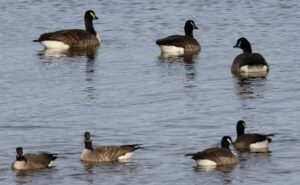
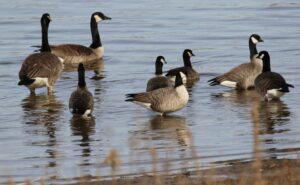
Canada Goose (Branta canadensis) and Cackling Goose (Branta hutchinsii). These two species used to be one species – Canada Goose. But in 2004, several of the smaller subspeices of Canada Goose were separated out from Canada Goose and classified as a separate species – Cackling Goose. This was based on two major things.
First, DNA testing showed genetic differences between what were formerly smaller subspecies of Canada Goose (now the separate species of Cackling Goose) and the rest of the subspecies of Canada Geese. Secondly, their calls differ enough that most people can immediately tell the difference. However, what complicates this is while they tend to nest on different parts of the tundra in Canada, their nesting areas do overlap and where they overlap, these two now separate species interbreed. So in my opinoion, this is not over. As we refine DNA testing and more is done, this may change again. But for now, we have two species where we had one: Canada Goose and Cackling Goose.
So to summarize. How to distinguish Ross’s Geese from Snow Geese? Ross’s Geese will look to be about half the size – they look like miniature Snow Geese. Don’t think these smaller versions of Snow Geese are juvenile Snow Geese – they are not. They are a completely separate species.
How to distinguish Cackling Geese from Canada Geese? Cackling Geese are generally smaller – sometimes only half the size of Canada Geese. Cackling Geese necks will be shorter and more muscular and their beaks will be stubbier. Listen to their calls online. You will be able to hear a difference. And look at the range maps, Where you are is always important!
*Statistics from:
Partners in Flight
allaboutbirds.org
National Audubon Society

